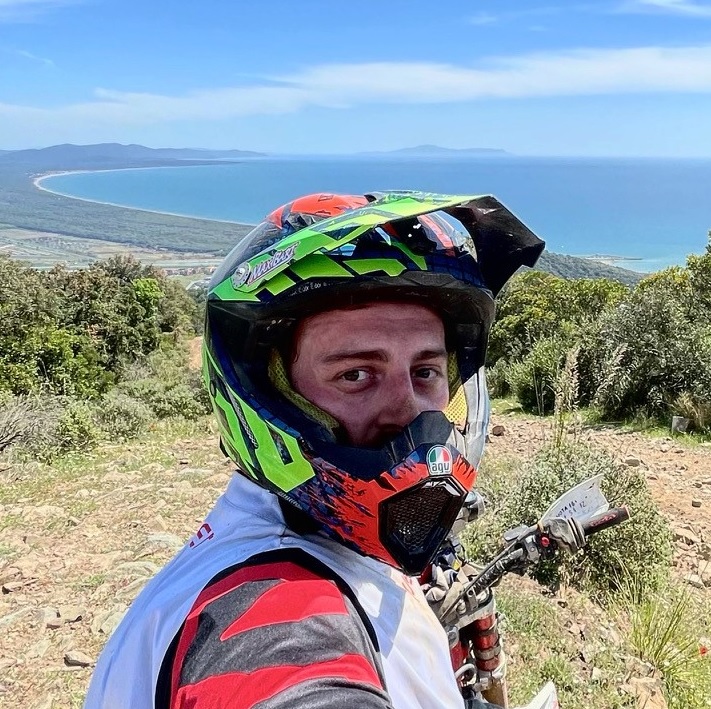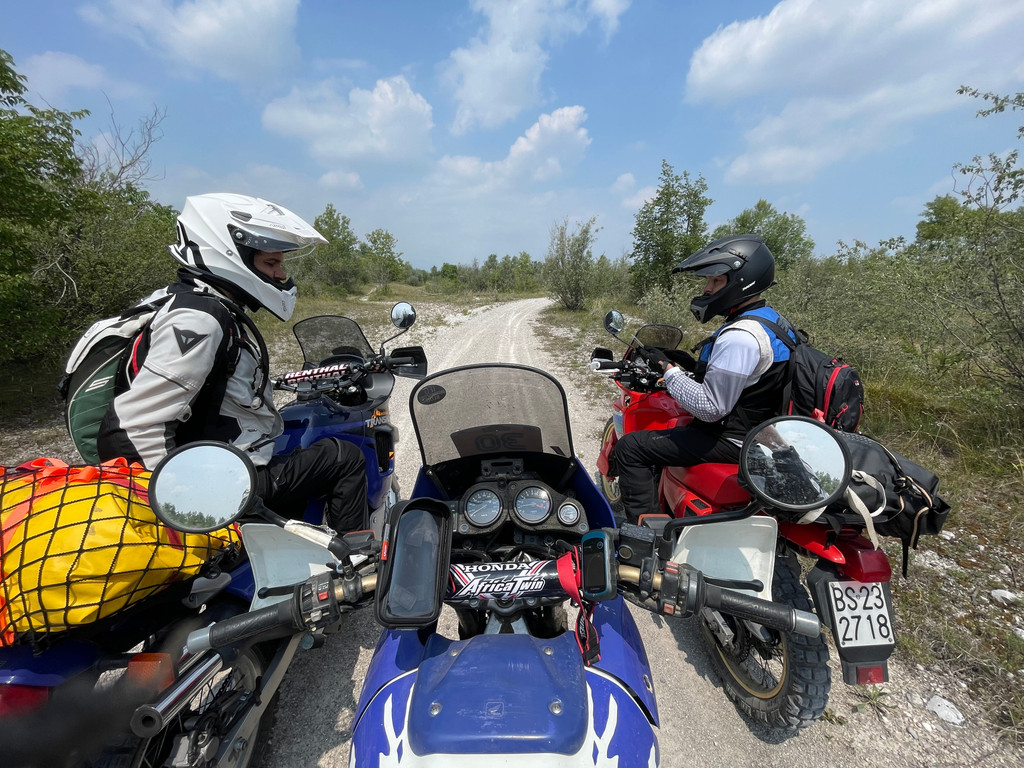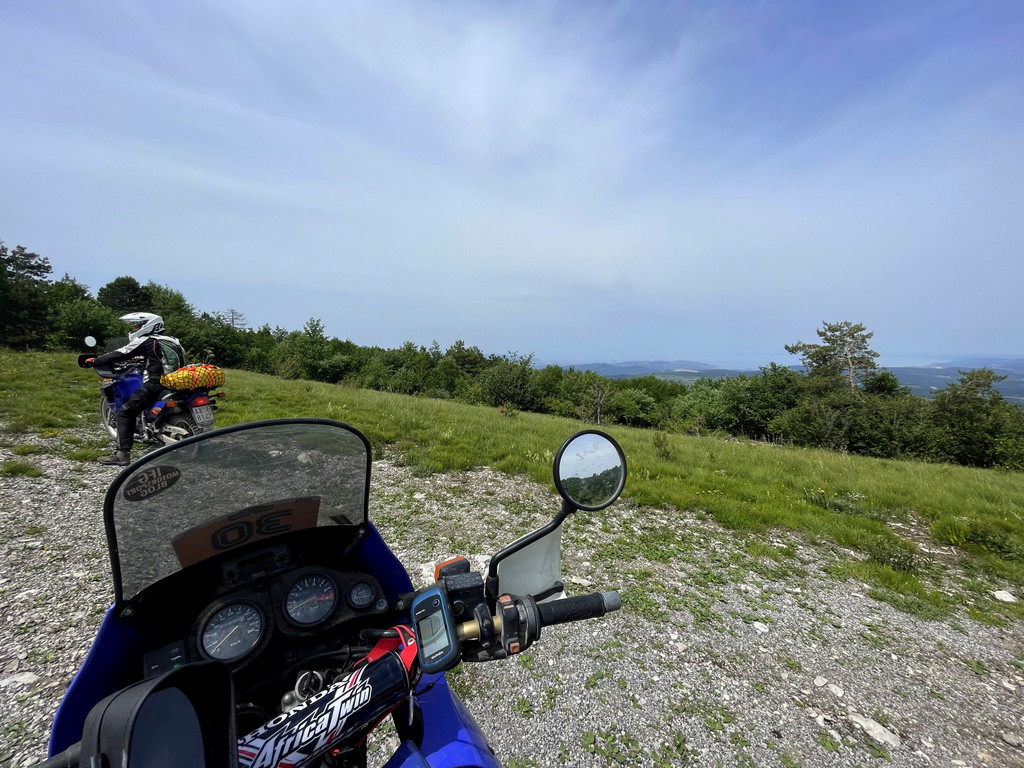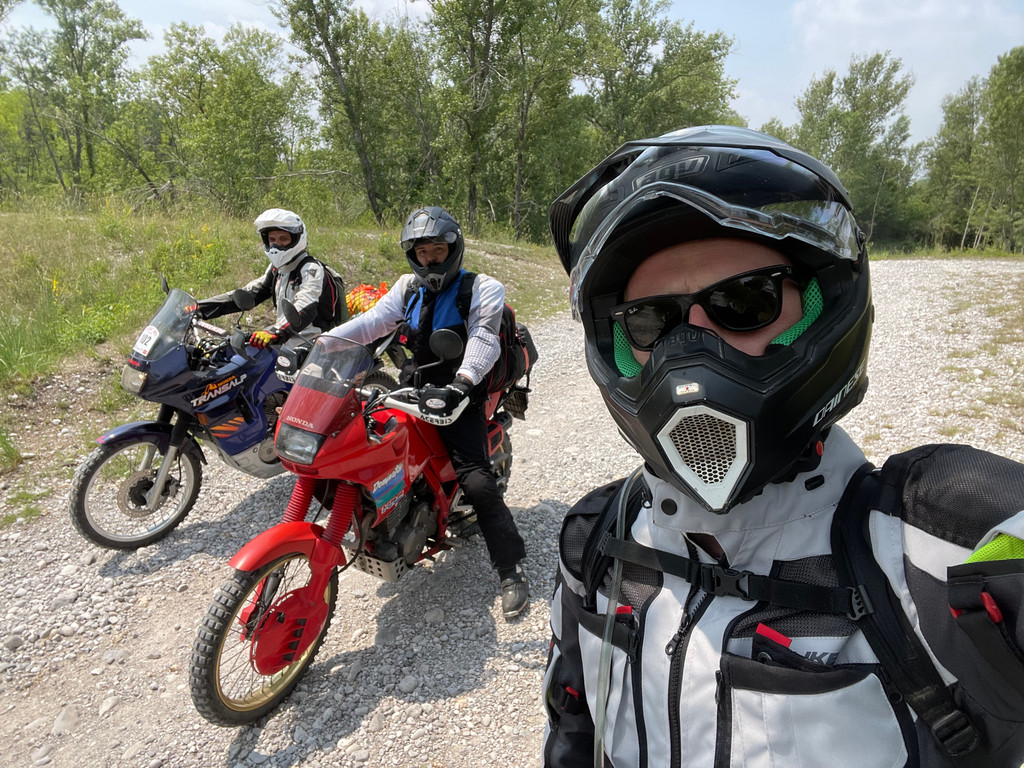
Carlo Pettinato, 30, I've been working at Dainese as part of the marketing since 2017. I live for sports on wheels, with or without an engine, but preferably with knobby tires. I’ve been passionate about enduro, mountain biking and rallying for as long as I can remember. After years on the track, I got an old Honda Africa Twin to keep my off-roader company. A new, vaster and more colorful world, of exploration, opened before me. Having set off from Sardinia, a wild land close to home, I dream of the desert dunes.
Once upon a time, someone wrote that there are two kinds of travel: Some people go on vacation, days are limited and as such itineraries are constrained, while others travel for the simple pleasure of traveling and learning. There’s a substantial difference between the two. People on vacation are usually rushed, while traveling for the sake of travel means one has the luxury of taking things slowly, appreciate the countries visited, get to know the people and, if necessary, stop awhile.
In all likelihood, however, only a few daring or privileged dreamers can afford to do the latter. The vacation scenario is much more common – traveling a week or two across that region we’d been yearning to see for so long. I consider myself lucky to be able to do this by motorcycle, rather than by other means. When you travel by motorcycle, your vacation feels different, you’re immersed in your surroundings, take in smells and varying temperatures, go for impromptu detours, even off-road.
If you have to stick to a schedule, however, it’s best to know your way, follow a route, so that you won’t waste a good part of your days wandering around aimlessly. Or is it? Isn't it always true that a GPX track is always synonymous with reliability?
The short break I took in Croatia some time ago is proof that this isn’t really the case, at least as far as I’m concerned – knowing where you’re going is not always the better option. On the contrary, sometimes following the beaten path can lead to blunders. But let's start from the beginning.

Me, Filippo and Francesco. Only three of us, out of the five who went on a legendary tour of Sardinia three years ago. Two out of three motorcycles are the same, all Honda models from the 1990s – Africa Twin, Transalp, Dominator. We don’t have as many days available this time, but we’ll try and make the most of a long weekend break, as thanks to June 2 – Italy’s National Day – falling on a Thursday, the bank holiday will include Friday, too. Our destination can’t be too far, as we can’t afford to spend too much time on the highway or various ferries to get there. Another key requirement is that the trip must include some off-road riding – we want our old motorcycles, and especially us, to have some fun. The answer to our riddle, as mentioned above, is Croatia. Beautiful, with sea and mountains, only three hours away on the highway, and with off-road riding bans that, we believe, are less stringent than in Italy. We set off.
It actually takes a whole day to get there, but we make sure to integrate it into the “journey”. We meet in Padua on the morning of Thursday, June 2, and briefly take the highway up to the Pordenone area. Here, we set our wheels on stony ground – the pebbly shores of the Cellina and Meduna rivers. We randomly follow some 4x4 tracks that run along the banks closest to the river beds. Our first GPX track starts from the village of Vivaro – basically, we wanted to cross the Friuli region through a different route, avoiding the asphalt as much as we could. The direction is toward Buttrio, passing to the south of Udine. This being a flat area, we don’t expect any interesting trails or breathtaking views, yet the wide dirt tracks crossing the fields are smooth and pleasant nonetheless, especially in the late afternoon, when the sun begins to set and the light changes. We only follow the track to the proximity of Pozzuolo del Friuli and then head toward the sea. Our first destination for the night is Aquileia. We take the opportunity to cross Palmanova, a splendid Venetian city that was fortified in the 16th century, a unique place due to its nine-sided polygon shape. We spend the evening in Grado, however, a seaside town founded in the 5th century and whose historic center features several excavations of ancient mosaics. This also deserves a visit, and, like any tourist destination, there are plenty of places for dining out.
On Friday, we leave our accommodation and head toward Trieste, or Dolina to be exact, where the real track we’re so eager to explore begins. This track was put together, in the last few months, by a fourth friend who had to cancel at the last moment – going on this adventure is a tribute to his efforts, and we soon find evidence that the statement I made above about beaten paths is indeed correct.
We leave the asphalt and start climbing along a rocky carriageway that, after less than 100 meters, meets some railroad tracks. The trail continues beyond but crossing them with motorcycles weighing 200 kg is unthinkable, also due to an embankment, just a few meters before the tracks, insurmountable to ‘non-trial’ vehicles. Just one minute after our real start and we’re already forced to make our first U-turn. We cross the Italy-Slovenia border on asphalt and will find a way to resume our route a little further on. In any case, we try to avoid the main thoroughfares in order to enjoy, even if on asphalt, the woods and sights around this borderland.
The plan is to cut straight through Istria and head directly to Dalmatia, ideally going as far up as Zadar. Following our own tradition, we’ve carefully avoided booking any accommodation in advance – mainly not to be forced to rush and make up for any wasted time and distance. And, perhaps, given the unforeseen events that soon followed, this was the right thing to do.
So, we cross over to Slovenia, where we finally manage some off-road riding. A wide and smooth dirt track awaits us, running between maritime pines, only a few hundred meters above sea level. Every so often, the trail emerges from the woods, crossing a clearing from which, to the right, the port of Trieste and all its ships can still be glimpsed. Now we’re really starting to feel that vacation vibe.

Some kilometers later, the track leaves the main road and dives into a smooth trail that turns back toward the intensely green hinterland. Our average speed slows down, but we’re still crossing woods and clearings of a rare beauty, and the vegetation and scents are different. For a long time, we don’t encounter a living soul or any signs of civilization, other than the trail we’re on. We should cross the border again, this time between Slovenia and Croatia, off-road. But what’s going on? Is there no customs when entering Croatia? Yep, there is – and you have to show your documents. We only realize this when, still riding along the trail, in the middle of the woods, we find ourselves in front of a huge, barred metal gate, complete with a three-meter high fence and rolls of barbed wire. Another U-turn. See what I mean? A GPX track is not synonymous with smooth sailing at all. We retrace our steps and, haphazardly following some spectacular dirt tracks crossing a beech forest, we reach the asphalt. We go through customs between Starod and Pasjak, show our documents, and it's time for lunch. How many kilometers have we covered so far? Better not think about it.
In an unassuming tavern in Permani we have cevapcici and spit-roasted suckling pig on a spit (excellent) – it’s the least we can do to cheer us up after such a bittersweet morning that has left us dissatisfied. Wonderful routes, but too many forced detours and a lot of wasted time. We’ll try and make up for it in the afternoon. Lunch break is also our favorite moment for choosing the destination for the evening. Given the hourly average so far, and without having any idea what to expect, we curb our ambitions and look for accommodation in Senj, on the sea, about eighty kilometers further south.
The afternoon starts well, along a slow and rocky yet smooth trail still immersed in nature. A little further on, I have an exciting encounter with a small group of fallow deer – only I have this pleasure, as I’m leading the way. I immediately stop to ask my friends if they’ve managed to see them, but their “See what?” tells me they weren't as lucky as me. We cross another splendid green clearing, which would be the perfect camping spot if only we had tents and were at the end of the day. But let's go on. The trail narrows dangerously, runs alongside a dry creek bed, there are some rocks but it’s all good. I take a look at the GPS and I see that the track is becoming dangerously steep as compared to the contour lines. We start to worry but, good enduro riders that we are, we push on anyway, also because we’re in the middle of nowhere, and yet another turnabout would mean that by the middle of the afternoon we’d have made very little progress.
The trail climbs up the side of the hill, getting increasingly narrower, steeper, stonier and rougher. Let me remind you that two out of the three of us are riding two-cylinder motorcycles, properly knobbed and not particularly loaded but, nonetheless, 30-year old two-cylinder vehicles. When I find myself having to yank the motorcycle with my body to get over a step of rock, praying not to lose my balance, I realize that what we’re doing now is true enduro riding but on basic road vehicles. I don’t mean really challenging enduro riding, by all means, you’d be fine with a specialist single-cylinder motorcycle here, but reaching the top it’s a slog, nonetheless. Once over what I believe must be the worst, I stop and get ready to give my friends a hand, and fortunately they come through unscathed.
I glance at my Garmin system again. Yep, this is the right way. What is now officially a mule track goes on with deadly hairpin turns that have to be tackled strictly in first gear and holding the clutch. When the Africa’s cooling fan comes on, I seriously start to fear for the health of the clutch – I try to use it sparingly so as not to burn it out and find myself stranded on foot in the middle of some godforsaken woods. One more break, and just a few meters below me I hear the unmistakably nasty sound of a fall. It’s Francesco who, on his Dominator, has lost his balance in the middle of a particularly slanting right bend. Fortunately, it’s nothing serious: The rider is unharmed, the front brake lever is broken in half yet still usable, the mirror is gone and the fender is bent. We take the opportunity to catch our breath – distraught, the three of us look at each other and curse our absent friend who’s put this track together. Piercarlo, where are you? You should be here, sharing our pain.
The stony trail is far from over. Three or four of these tight and steep hairpin turns yet to go, then I see that the contour lines suggest that the incline should even out. I climb slowly and with painstaking care, as falling with a 230-kg motorcycle here on the stones could be disastrous. The hillside flattens, I breathe a sigh of relief and finally realize where we are. This mule track seems to be an ancient road, paved in places, the remains of human settlements that, most probably, also included the low dry stone walls we spotted in the middle of the woods before we started climbing. A kind of reward, at least, after so much effort. Only now I dare imagine what might have happened if the ground had also been damp.
The trail begins to descend and I have another breathtaking encounter. Not fallow deer this time, but a group of adult deer with impressive antlers, roaming free in the woods, among low trees with little foliage that allows for a clear view. This time, all three of us manage to stop and admire them as they warily edge away from us. It’s a thrilling sight.
Shortly after this exciting moment, the trail finally meets a driveway. Our GPX track suggests turning left, which would mean climbing toward the mountain top – I’m sure the views would be amazing, but we don’t even feel the need to discuss it – rather, it’d be good to come back another time with lighter motorcycles and complete the route. It’s now late afternoon, we’re soaked in sweat and we strongly believe that the last hour was worth a full day of off-road riding. We turn right and return to civilization. Bottom line: We steer our motorcycles back toward the asphalt, just a few kilometers from where we had lunch, for an average hourly afternoon rate of perhaps about 10 km/h. Now we’ll just follow Google Maps straight to Senj. The coastal road, combined with the mild climate and the sun that’s about to set, makes for a totally relaxed descent toward our destination, which takes an hour.
Dinner is a time for sharing our thoughts and reminisce about what we’ve been through, as if we’d need to relive it – but we also try to decide what to do with the rest of our vacation. Meanwhile, dishes of calamari in bùzara sauce, grilled squid, octopus with potatoes and a starter of ray fish in oil and other delicacies are brought to our table, set just a few meters from the beautiful Senj port.
We have no hope of completing the itinerary. We’ve just reached our first Croatian stop and we’re perhaps only halfway through the route we’d originally planned – our conviction that we’ll make it to the end begins to fade. But we still have two days to enjoy, so we decide to go for a makeshift itinerary that comprises the stretches we missed out on our first day, which we’ll follow in the opposite direction, as well as the beloved TET – the Trans Euro Trail – that’s not far from here. Months of planning thrown to the winds.
The third day, the second one in Croatia, begins with a climb to the mountains above Senj, easy trails overlooking the sea and the island of Krk. Today we head back north following only wide dirt tracks that run amid beech and coniferous woods. In our minds, they feel just like World Rally Championship tracks. We mix up our track with the TET, for an assortment of stretches that works surprisingly well – only one forced turnaround due to a barred trail, and lunch break in Delnice. We’re still in the middle of nowhere when the Garmin system tells me to leave the main road and climb up through the pine forest on a mule track that seems rather smooth. Let's see. We climb for a couple of kilometers and another turn would take us onto a single track that, once again, has all the makings of a real enduro trail. We don’t fall for it and get back on the main road, continuing at random toward our newly chosen destination, Rijeka. A little further on, we discover to be near the border with Slovenia, at the Gumance Plateau. A splendid and vast green clearing in the middle of the forest, with the remains of stone buildings that, once upon a time, most probably acted as a customs house. There’s also an old quarry that I cannot help but explore on my motorcycle. I ride through puddles and piles of gravel until I get stuck in the sand. I call for help, receive a deserved scolding, and the three of us manage to rescue my Africa Twin.
Another evening overlooking the sea in the beautiful yet run-down city of Rijeka. With yet more grilled squid filling our bellies, we draw up an utterly unusual plan for our last day, not very much in line with the adventurous spirit of the trip: A visit to the Automotodrom Grobnik, the legendary Rijeka racetrack opened in the 1970s, which hosted the Yugoslavian motorcycle Grand Prix World Championship until 1990. A large, wide track that gives you goosebumps, as fans would tell you. We haven’t just come to visit this important historical site, however – above all, we’ve come to meet a friend and former colleague who’s here with his racing motorcycle. We enjoy a different kind of morning, a pleasant lunch on the hill overlooking the track and then we’re off home. We manage to avoid the queue at customs by going through the narrow and remote Podgorje pass – when we get there, there are only three cars waiting in line.
From Trieste onward, we just follow the highway, not just to save time but also to remind ourselves of how reliable and versatile our thirty-year-old motorcycles still are. How many other vehicles could have dealt with yesterday’s mule track and hairpin bends and, today, easily breeze along the A4 Turin-Trieste highway?
While, for a single four-day vacation, the motorcycle requires little advance preparation – which includes the choice of tires – readying oneself to deal with different conditions is important, to avoid getting caught off-guard by changeable weather conditions or any other unforeseeable events.
For this motorcycle tour in Croatia, at the beginning of June, I’ll confess I was slightly optimistic, mostly in terms of temperature. Highs were expected to stay below 30 °C, so I opted for a four-season suit in its summer configuration, with all the air vents open. Due to the intense off-road riding, however, I suffered from the heat for most of the time. Only now and then I felt perfectly comfortable, such as along the stretches at a higher altitude and in the shade of the woods. To get more airflow going during low-speed stretches, I often had to ride with the jacket half open. I certainly would have been better off with a perforated jacket-pants suit, with perhaps the addition of a layer for evening travel.
Motocross boots, on the other hand, are always my favorite on any adventure ride. They feel good because I’m used to them, I’ve always have them on when riding my enduro motorcycle so that, to me, it’s just like wearing sneakers. I’d rather lose out a bit in terms of practicality but gain maximum safety and confidence when off-road matters get serious. It’s good to choose an adventure helmet, which combines the comfort of a road helmet with the ventilation and peak of a motocross one, as well as off-road gloves with rigid protections on the knuckles.
I never go on journeys like this without my backpack with a two-liter water bag. I’m used to drinking a lot and having water always at hand is essential for me. Moreover, it’s also convenient for storing items you might need often, such as waterproof shell, wallet, power bank, sunglasses, etc.
Concerning the motorcycle’s preparation, I’ve only been away from home for three nights, so there’s not much to say beyond the choice of tires. For these short mixed on- and off-road journeys I always opt for aggressive knobby tires – true, they don’t last long on asphalt, but I’d rather be safe and have some fun off-road. In this particular case, considering the trails we tackled, the Mitas E09 tires were an excellent choice, as they’re definitively among the best off-road tires for this type of motorcycle.

For the rest, a bag securely fastened to the luggage rack was enough. A strap and a stretch luggage net kept it perfectly in place all the way through. Inside, I packed my enduro pouch, as well as some change of clothes, where I keep essential tools for outings and races. A flathead and a cross screwdriver, cutter pliers, scissors, 8, 10, 11 and 13 spanners, wrench for the rear wheel nut, a set of hexagonal wrenches, some wire, ties and some mixed screws and nuts. This kit usually serves me well, even if I don’t have great skills as a mechanic. Under the motorcycle seat: Spare fuel pump (one of the two flaws of my old Africa Twin is that the fuel pump breaks easily, while the other one concerns the voltage regulator), duct tape, insulation tape, more ties and two tire inflator and sealer cans, in case of punctures. I rarely use the latter, but they can come in handy. But I gave up my trusty tank bag, very useful yet uncomfortable when you have to go off-road and ride in a standing position.
On the handlebar: Mobile phone holder on the left, only used when traveling on road following Google Maps; Garmin GPS reader on the right, used for all off-road stretches where there was a track to follow.
And here we are, some conclusions. This darn track. Was it a good or bad idea? If Piercarlo hadn't spent the spring planning the trip, we certainly wouldn't have left (without him, by the way). So, yes, it was essential to the success of our long weekend break. Yet, I can say with certainty that, considering our motorcycles, we found the majority of really beautiful and pleasant off-road stretches by randomly riding on the coast and among the mountains of Croatia. So, what can I say? There are no real conclusions to be drawn. If you have tracks that have been tried and tested by reliable travelers then follow them, by all means. This, however, precludes that feeling of spontaneity that, while perhaps causing some frustration at the time, in the end added some zing to the whole adventure. So, whether you’ve planned your destination meter by meter or not, the important thing is to set off.